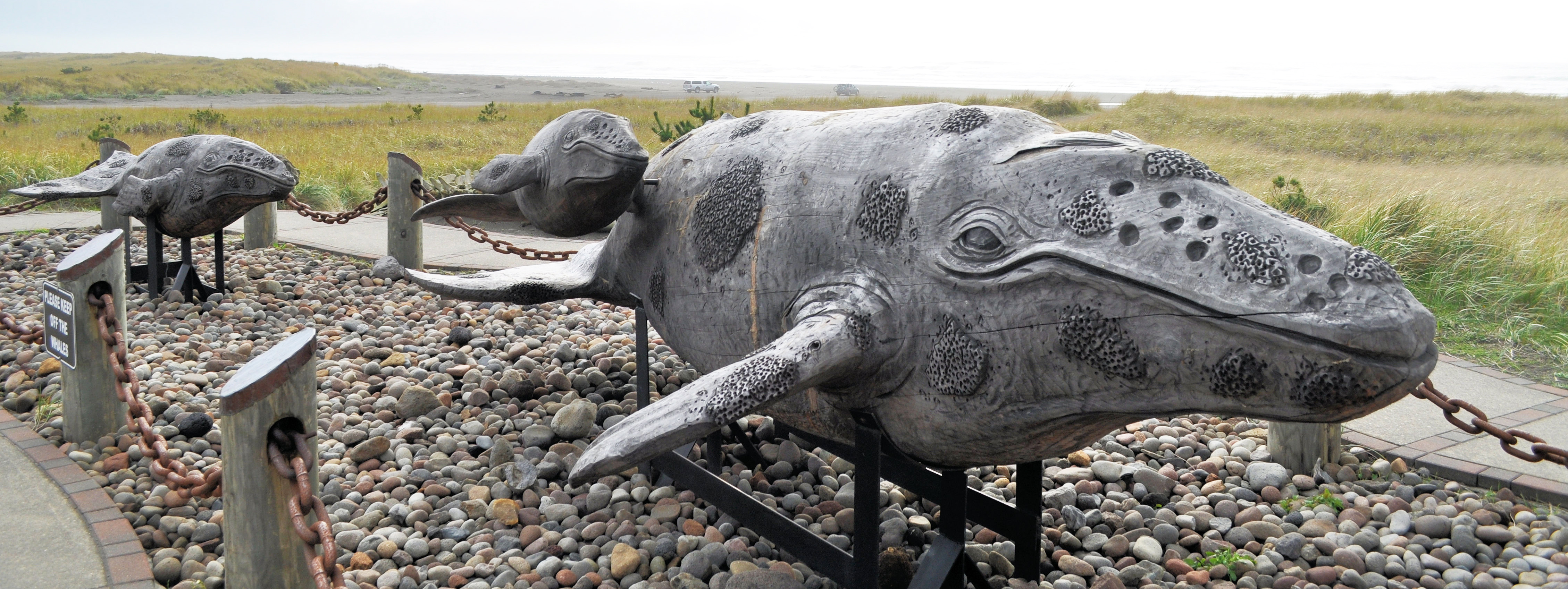Long Beach, Wa. — We stand on a windswept grassy dune breathing in the heavy sent of saltwater. To our left, the Pacific Ocean crashes in a rhythmic drum against the long stretch of beach. In front of us is a wooden sculpture of three gray whales, carved barnacles and all. Perched above the ground, they seem to float into the grassy dunes, swimming northward to their feeding grounds. It’s then I see a real whale skeleton behind them. Upon closer inspection, parts of its bones have turned green and ochre. Unlike the wood, it seems to be becoming part of the landscape history of this place.
William Clark of the Corps of Discovery saw such a whale in this very spot, noting the whale’s backbone joints in his journals. Even though it’s been over 200 years since the Lewis and Clark Expedition, I find myself in awe that I’m in the spot they were and that maybe, just maybe, my feet are tickling very same ground.
Fuelled by the desire to follow in their footsteps, we head back to our beach lodging, the Adrift Hotel & Spa,
and check out complimentary beach cruisers. Moments later, weare riding down the paved 12km Lewis & Clark
Discovery Trail to Beard’s Hollow. It is there that Clark and 11 men started their walk up the 42km stretch we know today as Long Beach.

Above: Wooden whales remind us of the awe Lewis and Clark experienced when they first set eyes on the sea monsters.
Even though the afternoon is overcast, we can see marshlands and the forested headlands of Cape Disappointment State Park up ahead. Once we arrive, we realize our timing is off. Not only is the sun setting, but the waves are inching forward eating up the sand around the rocks we need to cross. Knowing it’s a losing battle, we park our bikes and walk as far as the ocean will let us.
When we turn around the view strikes me. As far as the eye can see there is water, sand and dunes. This is the landscape Clark would have seen. I walk along the beach, ignoring the only sign of modernity here — car tracks and a picture of Clark stopping to investigate the cluster of seaweed, making a few notations in his notebook before continuing.
The next day, after a savoury breakfast of elk biscuits and gravy and a wild mushrooms scrambled eggs at the Shelburne Restaurant & Pub, we drive to Cape Disappointment State Park. The park juts into the Columbia River and abuts the Pacific Ocean. Upon a prominent ocean-facing cliff side with views of Cape Disappointment Lighthouse sits the Lewis and Clark Interpretive Center. The centre is dedicated to the Corps of Discovery and starts at the beginning of the expedition with a heavy focus on the journey and stops in Washington State. We spend a couple of hours going through the exhibits learning about their hardships — like eating candles for dinner during a period of starvation — the gamble of canoeing down the swift rapids at the now dammed Celilo Falls, and the joys of seeing the Pacific, knowing it meant they could prepare to return home.
In the park, we stop at McKenzie Head, a rounded hill Clark and his men camped on for three days while exploring the peninsula. The hike is short and steep, and by the time we reach the top we are winded. When the group camped here, the hill projected into the ocean and it had very few trees. Today, the landscape is much different. A manmade jetty formed land where sea was before and the hill is strewn with trees. Another part of history has also left its mark — gun batteries from World War II.
We linger near the edge of the hill, watching the sun set slowly into the sea. Then we head into town for pre-dinner drinks at North Jetty Brewing. For dinner, we dine at 42nd Street Café & Bistro and try local razor clams, a delicacy surely the explores tried too.

Above: The Washington coastline is one of the most stunning in the world - a paradise for travellers and sportsmen.
On our final day, we decide to end our Long Beach adventures exactly where Clark did, a tree that he carved his initials into with the date November 19, 1805. The walk from the parking lot to Clark’s Tree is short and easy. Located on the north end of the Lewis and Clark Discovery Trail, the original tree unfortunately disappeared years and years ago. Now, a bronze tree commemorates the original. We see the distinctive lone tree long before we stand in front of it. It is surrounded by golden grasses, its short limbs stretching upward to a blue sky filled with wispy clouds. Behind it, the constant, endless blue ocean, a part of this landscape that hasn’t changed since the Corps of Discovery set foot on the sand. •
About the Author
Lara Dunning lives on an island in Washington State, and her travels often include Pacific Northwest adventures. She has a serious passion for small town travel, history, culinary travel and light adventure. Lara has a MFA in Creative Writing, and writes young adult novels, creative nonfiction, and when she is not clicking away at the keyboard, you’ll find her hiking with Hazel, her Australian Cattle Dog.